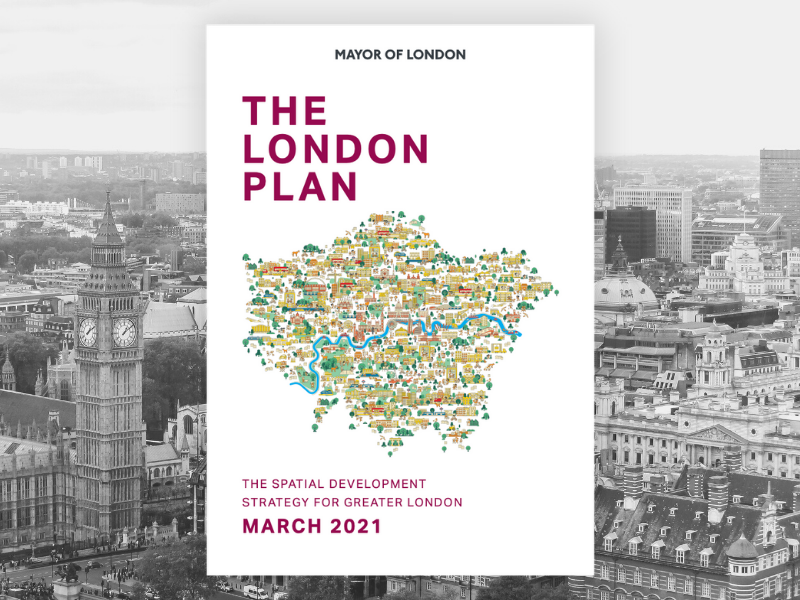4 minute read
Sigma Strategic Land (SSL)’s Damian Sullivan is in conversation today with experienced Chartered Town Planner and Director of Boyer, Mark Batchelor about The London Plan that was adopted last year.
Mark is based in Boyer’s Southwark office in London. Boyer is a highly regarded planning consultancy with in-house design services, as well as offering land and site promotion services.
Mark advises on a wide range of residential schemes with particular experience across the south London Boroughs including notable project successes in Bromley, Bexley, Croydon, Lewisham, Richmond and Kingston.
Mark has closely followed and contributed to the progress of the London Plan from its earliest inception, across the various stages of public consultation, up to and including attending its Examination-in-Public. With such close scrutiny of The London Plan 2021 over a sustained period of time and with experience of implementing its policies, SSL was keen to find out more…
- To begin with Mark and by way of a brief overview, what have your experiences been of the London Plan, particularly through its policy-making stages?
From the outset, we were involved in advising clients on the impact of the emerging policies and all of the team in our London office attended various sessions throughout the EiP, with particular interest and focus on the new housing targets (with the increased emphasis on supply in the outer Boroughs) as well as the emerging objectives around small sites, employment and co-location and what opportunities these present.
We have active projects across most London Boroughs, ranging from small scale development proposals up to major strategic schemes which are referable to the Mayor so since the adoption of the Plan we have very much got to grips with how the policies work in practice, the GLA’s approach to their application and the approach different Boroughs are taking.

- The London Plan was meant to be more strategic in its purpose. To what extent do you think it succeeds in this aim, mindful of its actually quite detailed policy tests?
The Plan’s greater emphasis and attention on the significant potential offered by small sites echos the Government’s acknowledgement of this in the NPPF and reflects the greater attention now on the delivery of the housing London needs in the more suburban Boroughs, which generally have seen the greatest increase in their housing targets.
There is a vast opportunity and potential for housing delivery on small sites. Generally speaking, they are quicker to identify, acquire and deliver so they have a very important role to play in delivering homes for Londoners across the plan period.
In general terms, my view is that across its various iterations, the London Plan has become increasingly detailed with attention being given to granular level detail such as marketing requirements where developments will result in the loss of commercial space. Historically this has been left to Boroughs to determine (and to an extent still is), but the new London Plan provides a threshold that should be met where LPAs don’t have their own standard in place.
The greater focus on detail is reflected in the new and enhanced policy tests around matters such as fire safety (which although supposedly only relevant to major development proposals, is now becoming increasingly relevant to minor schemes as well), urban greening and SuDS.
- The Major of London avoided undertaking a strategic Green Belt review when developing The London Plan. Do you view this as something of a missed opportunity or a reasonable position to adopt in the circumstances?
This is one of the most commonly asked questions when speaking with clients about medium – long term strategies. My own view is that the acute housing shortages in London won’t be resolved until there is a strategic and pragmatic review of the Green Belt and the Inspectors’ Report into the 2021 London Plan hints at the need for a boundary review, stating “it is difficult to see how the number of housing units could be increased without consideration being given to a review of the Green Belt”.
I am advising a number of clients at the moment on sites that are designated Green Belt but are previously developed and which fulfil none of the purposes of the Green Belt. They are scruffy, unattractive and have no (or only very limited) positive environmental or ecological benefits. Applications to develop those sites are routinely refused because it’s Green Belt despite wider issues around poor housing supply and delivery in that area.
Something has to give somewhere and if Councils are determined to protect the Green Belt from development then there should be a greater level of support for tall building development and densification. The latter is emphasised at various points in the London Plan, but the tall building policy is somewhat obstructive, pushing the emphasis on determining where these are appropriate towards the Boroughs.
I suspect that a Green Belt review will need to be initiated by central government and I do think there will be one, but perhaps not for many years to come!
- The new Plan places great emphasis on the role of small sites and further sets out a design-led approach to density. What’s your experience of this in practice?
The focus on small sites is an important new aspect of the Plan. These sites were always in existence and have always been important contributors to housing delivery, but it’s interesting that they now are taking more of a centre-stage role with Councils having defined targets to be met in terms of delivery from such sources. The design policies in the Plan sit hand-in-hand with the small sites policy, making clear that it’s inevitable that an area’s character will “evolve” over time to meet London’s housing needs.
Different Councils approach these policies in different ways and I have some experience of these points being entirely ignored, or at least not properly grappled with at the application stage. They are, however, important and they really are designed to facilitate the optimisation of low-density suburban parts of London, especially around key public transport nodes and town centres.
The seemingly never-ending supply of small sites across London has always been and will continue to be, an area where there is an abundance of opportunity and potential in years to come. High quality, well-considered and justified architecture will be key to unlocking the full potential of these sites.
- To what extent do you think that The London Plan will be successful in delivering the housing London needs?
It is widely accepted that there is acute housing need across London, it’s a strategic issue and there are examples of Boroughs at the moment which don’t have a 5-year land supply in place and the result is the development plan policies most relevant to housing supply are out of date, including those which have only recently been adopted in the London Plan.
There is something of a recurring theme through Inspectors’ reports on draft London Plans – they acknowledge the acute level of need that exists in London but due to constraints on land availability and supply, the actual need cannot be met. This was the case with the FALP, where the Inspector in his report made clear his views that the targets being adopted would not deliver sufficient homes to meet objectively assessed needs. He recommended adoption subject to an immediate review of housing targets.
The 2017 SHMA identified the need for 66,000 additional homes each year across London with the adopted Plan establishing an annual target of just over 52,000 additional homes each year across London.
The planning process is becoming increasingly complex and speed is not helped by underfunded planning departments, which struggle to cope under the weight of work. As much as the Mayor would hope that the Plan does catalyse development across London until the resource issues being faced by LPAs are resolved, the system won’t be as effective as it should be and there will be delays to housing delivery.
- The London Plan states that a strategic target of 50% of all housing should be affordable housing. What have your experiences been of this in practice and how is this managed in terms of scheme viability?
Affordable housing is always something of a minefield with the 50% strategic target, the 35% target and the Boroughs occasionally adopting different targets altogether. The approach to the policy will naturally vary depending on factors such as the location of a site, the scale of development (i.e. is it referable to the Mayor) and the political persuasion of the Borough.
Policy H5 makes clear that viability is a material consideration in planning applications and there is increased focus on delivery and certainly my long-held view is that planning as a paper exercise is pointless; I don’t see the benefit in obtaining planning permission for a development that cannot be delivered given viability constraints. My advice to clients is always that even if the right strategy for a site involves extensive and difficult viability negotiations, that is preferable to securing permission for a development that never gets delivered.
There is added complexity on schemes that are referable to the Mayor given the need to negotiate with not only the Council’s viability assessors but also the viability team at the GLA. Mayor Khan made an election pledge to boost affordable housing delivery across London and the viability team has been established with the clear aim of helping him to meet that objective.
- How did you view the recent Planning for London Programme public consultation when it calls for stakeholders to contribute relevant research and evidence as being a foundational step for the new London Plan?
The consultation called for Londoners and other stakeholders to submit evidence such as reports and case studies to allow the GLA to understand how London should change in the future. It also invited personal accounts of how development affects different communities and called for examples (nationally and internationally) of best practice and ideas for how through engagement on the new Plan, a more diverse range of Londoners can be reached.
The consultation is part of the GLA’s evidence-gathering process. It will review all submissions and these will influence the direction of travel for a new London Plan, which in time will replace the version adopted in 2021.
The approach appears to point to a concern that existing and former iterations of the Plan have not necessarily been successful at identifying and reaching all communities who are, or might be, affected by the development process. London has a wonderfully diverse population and it’s right that the emerging Plan should reflect and capture the needs and aspirations of all who stand to be affected by its new policies.
Thank you Mark for your insightful and perspicacious thoughts shared with Sigma Strategic Land, very much appreciated.
Back to News
